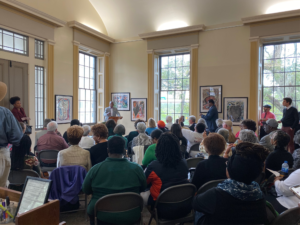
A collaboration between the Florida A&M University Black Archives Exhibition Research Center and Museum and the Florida State University Civil Rights Institute produced the “Remembrance of Slavery in America and Contributions of African Americans 100 Years Prior to 1619” program.
Held in the Old Union Bank at the corner of Calhoun Street and Apalachee Parkway, Thursday’s standing room only event was attended by several Tallahassee officials including Mayor John Dailey, County Commissioner and FAMU Professor Bill Proctor, Congressman Al Lawson and Rep. Theresa Fredericks.
On the anniversary of the arrival of the first English slave ship 400 years ago, recognition was given to FAMU on its achievements since the university’s establishment and the contributions its generations of graduates have made to the infrastructure of the state and nation.
Mayor Dailey read from a proclamation from the Tallahassee City Commission that recognized the significance and importance of the event before other officials addressed the audience.
The common consensus at the event was to integrate obviously relevant Black history into mainstream American history, as it is commonly disregarded.
“1619 was not that long ago, however it has been an uphill struggle to share and to overcome a constitution that gave Africans at least a three-fifths foundation, and to overcome that three-fifths beginning has been a tremendous march up hill,” Proctor said.
“If you really want to think about the significance of contributions of African Americans, begin to subtract the days, the weeks, the months of free labor to America and see what America is. Subtract the contribution from science, from math, from NASA, subtract from everything that’s American life, then you would know where America would be standing, not very far, not even three-fifths the distance which it is today,” Proctor added.
Distinguished FAMU history professor Larry Rivers wanted to remind attendees that Florida’s history of slavery began long before the official recordings of slave ship arrivals, 100 years to be exact.
“We’re here this evening to celebrate a people that very few people think about when they think about building America,” Rivers said. “Even before the first 20 Africans, almost back to 1500s Florida, you could find Africans some enslaved and some not enslaved, who worked in Spanish Florida, who worked for almost a century before we start thinking about the 1619 experience.”
Rivers made sure to localize the impact of Black Americans’ contributions by sharing with the audience that Commissioner Proctor’s own ancestors, Antonio and George Proctor, helped to build the state Capitol building one block away from where they were gathered.
More information can be found about slavery before the slavery in “Slavery in Florida: Territorial Days to Emancipation,” authored by Rivers.
This collaboration project was the first of a variety of events exploring slavery’s impact on Florida.